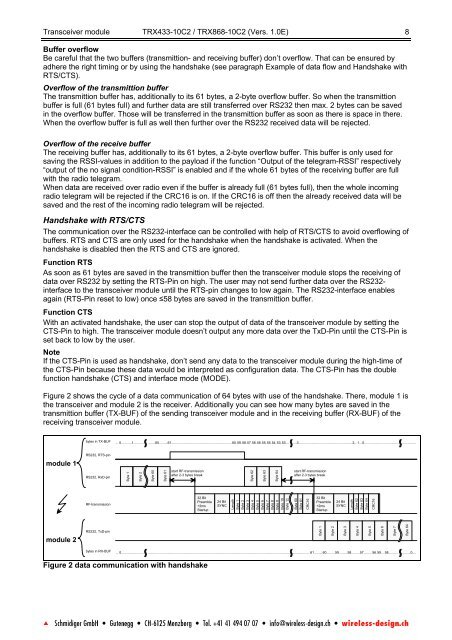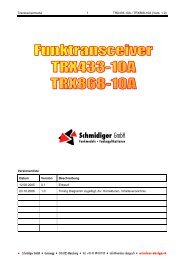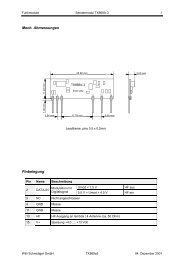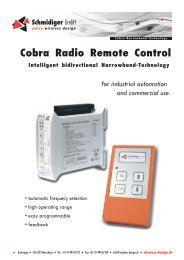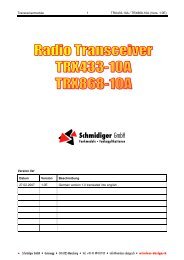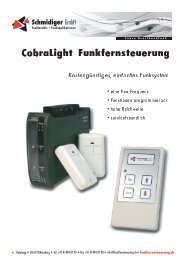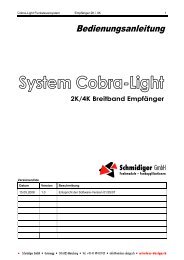Version List
Version List
Version List
Create successful ePaper yourself
Turn your PDF publications into a flip-book with our unique Google optimized e-Paper software.
Transceiver module TRX433-10C2 / TRX868-10C2 (Vers. 1.0E) 8<br />
Buffer overflow<br />
Be careful that the two buffers (transmittion- and receiving buffer) don’t overflow. That can be ensured by<br />
adhere the right timing or by using the handshake (see paragraph Example of data flow and Handshake with<br />
RTS/CTS).<br />
Overflow of the transmittion buffer<br />
The transmittion buffer has, additionally to its 61 bytes, a 2-byte overflow buffer. So when the transmittion<br />
buffer is full (61 bytes full) and further data are still transferred over RS232 then max. 2 bytes can be saved<br />
in the overflow buffer. Those will be transferred in the transmittion buffer as soon as there is space in there.<br />
When the overflow buffer is full as well then further over the RS232 received data will be rejected.<br />
Overflow of the receive buffer<br />
The receiving buffer has, additionally to its 61 bytes, a 2-byte overflow buffer. This buffer is only used for<br />
saving the RSSI-values in addition to the payload if the function “Output of the telegram-RSSI” respectively<br />
“output of the no signal condition-RSSI” is enabled and if the whole 61 bytes of the receiving buffer are full<br />
with the radio telegram.<br />
When data are received over radio even if the buffer is already full (61 bytes full), then the whole incoming<br />
radio telegram will be rejected if the CRC16 is on. If the CRC16 is off then the already received data will be<br />
saved and the rest of the incoming radio telegram will be rejected.<br />
Handshake with RTS/CTS<br />
The communication over the RS232-interface can be controlled with help of RTS/CTS to avoid overflowing of<br />
buffers. RTS and CTS are only used for the handshake when the handshake is activated. When the<br />
handshake is disabled then the RTS and CTS are ignored.<br />
Function RTS<br />
As soon as 61 bytes are saved in the transmittion buffer then the transceiver module stops the receiving of<br />
data over RS232 by setting the RTS-Pin on high. The user may not send further data over the RS232interface<br />
to the transceiver module until the RTS-pin changes to low again. The RS232-interface enables<br />
again (RTS-Pin reset to low) once ≤58 bytes are saved in the transmittion buffer.<br />
Function CTS<br />
With an activated handshake, the user can stop the output of data of the transceiver module by setting the<br />
CTS-Pin to high. The transceiver module doesn’t output any more data over the TxD-Pin until the CTS-Pin is<br />
set back to low by the user.<br />
Note<br />
If the CTS-Pin is used as handshake, don’t send any data to the transceiver module during the high-time of<br />
the CTS-Pin because these data would be interpreted as configuration data. The CTS-Pin has the double<br />
function handshake (CTS) and interface mode (MODE).<br />
Figure 2 shows the cycle of a data communication of 64 bytes with use of the handshake. There, module 1 is<br />
the transceiver and module 2 is the receiver. Additionally you can see how many bytes are saved in the<br />
transmittion buffer (TX-BUF) of the sending transceiver module and in the receiving buffer (RX-BUF) of the<br />
receiving transceiver module.<br />
module 1<br />
module 2<br />
bytes in TX-BUF ... 0........... 1........... ........60......... 61................................................................60.59.58.57.56. 56.55.55.54.53. 53.... ....3......................................................... 2...1...0..................................... ...............<br />
RS232, RTS-pin<br />
RS232, RxD-pin<br />
RF-transmission<br />
RS232, TxD-pin<br />
Byte 1<br />
Byte 2<br />
Byte 60<br />
Byte 61<br />
start RF-transmission<br />
after 2-3 bytes break<br />
32 Bit<br />
Preamble<br />
+2ms<br />
Startup<br />
24 Bit<br />
SYNC<br />
Byte 62<br />
Length<br />
Byte 1<br />
Byte 2<br />
Byte 3<br />
Byte 4<br />
Byte 5<br />
Byte 6<br />
Byte 7<br />
Byte 8<br />
Byte 9<br />
Byte 10<br />
Byte 11<br />
Byte 63<br />
Byte 64<br />
Byte 60<br />
Byte 61<br />
CRC16<br />
32 Bit<br />
Preamble<br />
+2ms<br />
Startup<br />
Byte 1<br />
Byte 2<br />
24 Bit<br />
SYNC<br />
Byte 3<br />
Length<br />
Byte 62<br />
Byte 63<br />
Byte 64<br />
bytes in RX-BUF ... 0......................... ........................................................................................................................................................... .................. 61.........60.........59.........58.........57.........56. 59... 58.......... .........0....<br />
Figure 2 data communication with handshake<br />
start RF-transmission<br />
after 2-3 bytes break<br />
Byte 4<br />
Byte 5<br />
CRC16<br />
Byte 6<br />
Byte 7<br />
Byte 64


